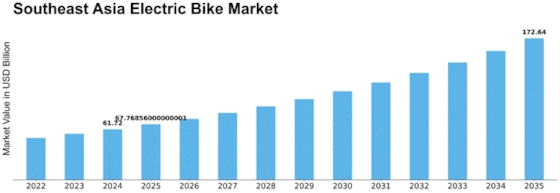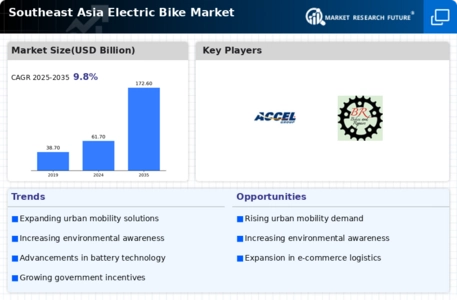Southeast Asia Electric Bike Size
Southeast Asia Electric Bike Market Growth Projections and Opportunities
The Southeast Asia electric bike market is influenced by various market factors that shape its growth and dynamics. One significant factor is the region's rapidly growing urbanization and population density. As cities become more congested and polluted, there is an increasing demand for alternative transportation solutions, such as electric bikes, which offer a convenient and eco-friendly way to navigate through traffic. Additionally, the rise in disposable income among the middle class in countries like Indonesia, Thailand, and Vietnam has contributed to the affordability and accessibility of electric bikes, driving market expansion.
Government regulations and policies also play a crucial role in shaping the Southeast Asia electric bike market. Many governments in the region are implementing measures to reduce carbon emissions and promote sustainable transportation solutions. This includes providing incentives such as tax breaks and subsidies for electric bike purchases, as well as investing in infrastructure to support electric vehicle adoption. Such supportive policies create a favorable environment for electric bike manufacturers and encourage consumers to switch from traditional gasoline-powered vehicles to electric alternatives.
Technological advancements and innovation are driving forces behind the growth of the electric bike market in Southeast Asia. With ongoing developments in battery technology, electric bikes are becoming more efficient, affordable, and capable of longer ranges. Manufacturers are also introducing features such as smart connectivity and lightweight materials to enhance the user experience and appeal to a broader audience. As a result, consumers are increasingly drawn to electric bikes as viable and practical alternatives to conventional bicycles and motorized scooters.
Consumer preferences and lifestyle trends are shaping product design and marketing strategies in the Southeast Asia electric bike market. As urban populations seek more sustainable and health-conscious modes of transportation, electric bikes are positioned as an attractive solution that offers both convenience and environmental benefits. Manufacturers are responding to these trends by offering a diverse range of electric bike models tailored to different user needs, whether for commuting, recreational riding, or cargo transport. Moreover, marketing efforts often highlight the cost savings and convenience associated with electric bikes compared to traditional vehicles, appealing to a broad spectrum of consumers across the region.
Infrastructure development and accessibility are critical considerations for the growth of the electric bike market in Southeast Asia. While major cities are gradually improving bike lanes and cycling infrastructure, there remain challenges related to road safety and congestion. Governments and urban planners need to address these issues to promote cycling as a viable mode of transportation and encourage more people to adopt electric bikes. Additionally, expanding access to charging stations and maintenance facilities is essential to support the growing number of electric bike users and ensure a seamless riding experience.
In conclusion, the Southeast Asia electric bike market is influenced by a combination of market factors that reflect the region's evolving urban landscape, government policies, technological advancements, consumer preferences, and infrastructure development. As awareness of environmental issues and the benefits of sustainable transportation grows, electric bikes are poised to play an increasingly significant role in shaping the future of mobility in the region. With continued innovation and investment, the electric bike market in Southeast Asia holds immense potential for growth and transformation in the years to come.


















Leave a Comment